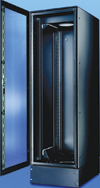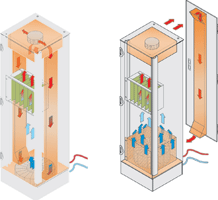
Electronic systems in harsh industrial environments often require only up to 3 kW of cooling capacity, but these must be closed systems that offer a specified level of IP protection. In certain locations it is also necessary to ensure a low noise level.
It is naturally as necessary for cooling to be variable, uniform and matched to specific needs as that it should occupy a minimum of space. The electronics used in industrial applications such as instrumentation and control systems typically generate between 1 and 2,6 kW of waste heat per cabinet. Pure air cooling is generally not possible in such situations, however, since industrial environments demand a high level of IP protection (IP55).
Previous cooling solutions have usually been based on the use of side- or top-mounted air conditioners or alternatively of side- or top-mounted air/water heat exchangers. These meet the need for a sealed cabinet while providing the necessary cooling capacity. However, these solutions also have certain disadvantages. They are prone to the risk of air short-circuits, since the air inlet and outlet are often not sufficiently far apart to prevent freshly cooled air being sucked back out of the cabinet before it has reached the electronic components. This problem can only be overcome through the use within the cabinet of air guides of variable complexity. Where the cooling unit is on top of the cabinet, the cold air must first be transferred to the bottom of the cabinet.
The second major disadvantage for such cooling systems is the fact that they are mounted outside the cabinet (on the side or top) and thus require extra floor space or headroom. Where the cooling devices are side-mounted it is also not possible to arrange multiple cabinets in rows. Side- and top-mounted air conditioners further generate a relatively high noise level (roughly 66 to 80 dB (A)). Finally, the warm air drawn out of the cabinet is issued into the surrounding environment, which is likewise not always desirable.
A new cooling solution, which forms a real alternative to add-on air conditioners or heat exchangers, is the use of an air/water heat exchanger (AWHE) situated within the cabinet. In the VARISTAR LHX 3, Schroff has developed a solution that avoids the disadvantages discussed above and offers the required cooling capacity of 3 kW. The AWHE is relatively small and is mounted either in the cabinet plinth or as a 19-inch plug-in unit. Warm air is sucked out by a fan in the roof of the cabinet and guided downwards through an air channel to the AWHE, where it is cooled. The cold air is then introduced back into the cabinet from below. Air short-circuits are prevented by the large physical separation between the warm air outlet and the cool air inlet.

The airflow pattern is optimised for mixed electronic components. The components are cooled uniformly by cold air moving upwards throughout the entire interior space of the cabinet. Cooling capacity can be increased, using a modified AWHE, to about 6 kW. This Schroff solution thus offers scalability up to 6 kW heat dissipation. At 45,2 dB (A) the noise level is considerably lower than that obtained with side- or top-mounted air conditioners. Further, the new design is room-independent; that is, ambient conditions do not affect cooling performance, nor does the cooling system burden its environment with noise and waste heat. The cabinet offers IP55 protection and is designed for a maximum static load-carrying capacity of 800 kg on the 19-inch plane.
Two versions for different needs
The Varistar LHX 3 is available in two versions. In one of these the AWHE and supply and waste pipes are contained in a plinth that can be inserted or removed from the front. Warm air drawn out through the top fan is directed down to the AWHE via two air channels in the side panels. This version is primarily suited to a single cabinet in which heat dissipation is relatively uniformly distributed throughout its volume. With this design the entire 19-inch mounting space is available for components.
In the second version, the AWHE is housed in a 19-inch chassis and can be positioned either at the bottom of the cabinet or at any chosen height within the 19-inch plane. Water supply and waste pipes conform to the appro-priate safety guidelines. Warm air drawn out through the top fan is guided back to the AWHE via an air channel in the rear panel. This version of the LHX 3 offers the user more flexibility. Positioning the AWHE at different heights allows a particular level of cooling to be directed to a specific part of the cabinet. Since the air channel is in the rear panel, it is also possible to group a number of cabinets with this type of cooling together. Multiple cabinets with a total heat loss of 3 kW can also be cooled by a single AWHE and top fan through appropriate positioning and the use of additional air guides inside the cabinets.

With the 19-inch chassis version it is also possible to employ adjustable and closable perforations (cold air outlets) on the top, bottom or side of the AWHE to direct cold air to specific hot spots. To ensure the optimal configuration, Schroff offers a thermal simulation of the heat patterns and the effect of the heat on the system using specially written software and also competent support from its team of developers.
Software for thermal analysis
Various computer programs provide a thermal analysis of complete systems. In developing its cases, subracks and cabinets, Schroff uses the Flowtherm simulation package. As a service, the company also offers its customers the use of its climate laboratory, including thermal simulation and the know-how of its cooling system specialists.
The principle of the simulation software is simple. A geometric model of the cabinet to be analysed is built up graphically from a set of components or component types. These component data can also be imported by the software from a CAD system. Where the program is being used purely for cabinet development purposes, the interior configuration is made up of an averaged test system using standard components that most closely represent the intended end-use of the cabinet. If, however, a specific customer project is being simulated, the components envisaged by the customer are ‘installed’ in the system instead.
Next, the physical parameters such as material coefficients, the power loss of the components, the power and performance characteristics of the cooling system and environmental parameters, etc, are specified. The software then calculates the coupled variables of convection, forced air currents, radiation and conduction, and displays the results on a 3D grid. The software plots the complete flow field (air speed and pressure) in the cabinet and also the temperature distribution of the air and the fixed bodies in the system.
The results are output as an analysis and graphical representation of the calculated flow field. On the basis of these results, steps can be taken to optimise performance, for example by changing the arrangement of air outlets, adding air deflector plates or repositioning the electronics. A number of variations are considered in order to achieve the optimum result. Next, the optimised design is physically constructed and the actual heat distribution measured in the laboratory. The laboratory results are also used in subsequent simulations through the introduction of appropriate correction factors. This practice constantly improves the match between theoretical and practical results.
| Tel: | +27 11 608 3001 |
| Email: | [email protected] |
| www: | www.actum.co.za |
| Articles: | More information and articles about Actum |

© Technews Publishing (Pty) Ltd | All Rights Reserved